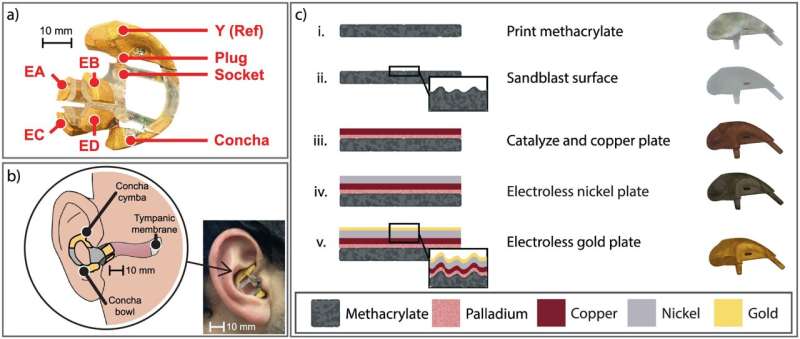This article has been reviewed according to Science X's editorial process and policies. Editors have highlighted the following attributes while ensuring the content's credibility:
fact-checked
peer-reviewed publication
trusted source
proofread
Dozing at the wheel? Not with these fatigue-detecting earbuds

Everyone gets sleepy at work from time to time, especially after a big lunch. But for people whose jobs involve driving or working with heavy machinery, drowsiness can be extremely dangerous—if not outright deadly.
Drowsy driving contributes to hundreds of fatal vehicle accidents in the U.S. each year, and the National Safety Council has cited drowsiness as a critical hazard in construction and mining.
To help protect drivers and machine operators from the dangers of drifting off, engineers at the University of California, Berkeley, have created prototype earbuds that can detect the signs of drowsiness in the brain.
The earbuds detect brain waves in the same way as an electroencephalogram (EEG), a test that doctors use to measure electrical activity in the brain. While most EEGs detect brain waves using a series of electrodes attached to the head, the earbuds do so using built-in electrodes that are designed to make contact with the ear canal.
The electrical signals detected by the ear buds are smaller than those picked up by a traditional EEG. However, in a new study published in Nature Communications, the researchers show that their Ear EEG platform is sensitive enough to detect alpha waves, a pattern of brain activity that increases when you close your eyes or start to fall asleep.
"I was inspired when I bought my first pair of Apple's AirPods in 2017. I immediately thought, "What an amazing platform for neural recording,'" said study senior author Rikky Muller, an associate professor of electrical engineering and computer sciences at UC Berkeley.
"We believe that this technology has many potential uses, and that classifying drowsiness is a good indicator that the technology can be used to classify sleep and even diagnose sleep disorders."
Using an earbud as an EEG electrode poses a variety of practical challenges. In order to obtain an accurate EEG, electrodes need to make good contact with the skin. This is relatively easy to achieve in traditional EEGs, which use flat metal electrodes stuck to the scalp. However, it is much trickier to design an earbud that will fit snugly—and comfortably—in a wide variety of ear sizes and shapes.
When Muller's team started working on the project, other groups developing Ear EEG platforms were either using wet electrode gels to ensure a good seal between the earbud and the ear canal, or creating custom-molded earpieces for each individual user. She and her team wanted to design a model that was dry and user generic, so that anyone could stick them in their ears and get reliable readings.
"My personal goal was to try to make a device that could be used every day by someone who would really benefit from it," said Ryan Kaveh, a UC Berkeley postdoctoral scholar and co-first author of the study. "In order to do that, I knew that it would have to be reusable, fit a variety of people, and [be]easy to manufacture."
Kaveh co-led the study with graduate student Carolyn Schwendeman and collaborated with Ana Arias's lab at UC Berkeley to design the final earpiece in three sizes: small, medium and large.
The earpiece incorporates multiple electrodes in a cantilevered design that applies gentle outward pressure to the ear canal and uses flexible electronics to ensure a comfortable fit. The signals are read out through a custom, low-power, wireless electronic interface.
In a 2020 paper, the researchers showed that these earpieces can detect a number of physiological signals, including eye blinks, alpha brain waves and the auditory steady-state response, which is the brain's response to hearing a steady pitch.
In the new study, they improved the earpiece design and incorporated machine learning to demonstrate how the earpieces could be used in a real-world application.
As part of the experiment, they asked nine volunteers to wear the earpieces while doing a series of boring tasks in a darkened room. Every so often, the volunteers were asked to rate their level of drowsiness, and their response times were measured.
"We found that even when the signal quality from the earpieces seemed worse, we could still classify the onset of drowsiness with the same level of accuracy as much more complicated, bulky systems," Kaveh said.
The earpieces also retain their accuracy when categorizing drowsiness in brand-new users, a characteristic of devices that could work "out of the box."
Muller, who developed the Ear EEG, is continuing to refine the design and explore other potential applications of the device, which can also record signals beyond EEG, such as heart beats, eye movements and jaw clenches.
"Wireless earbuds are something we already wear all the time," Muller said. "That's what makes Ear EEG such a compelling approach to wearables. It doesn't require anything extra."
More information: Ryan Kaveh et al, Wireless ear EEG to monitor drowsiness, Nature Communications (2024). DOI: 10.1038/s41467-024-48682-7



















